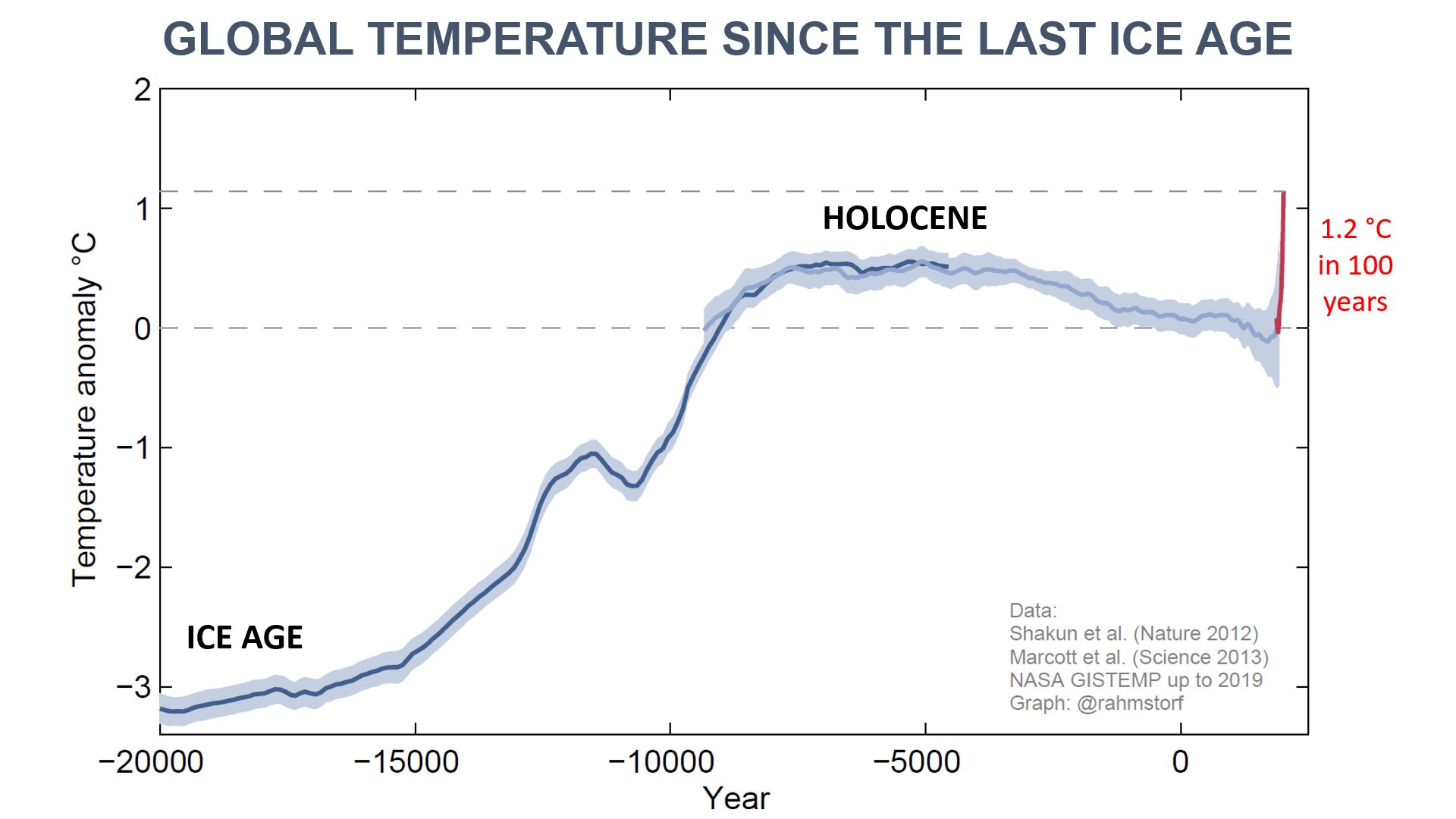Crop domestication
Motivation
The question must be raised: “Why farm?” Why give up the 20 hour work week and the fun of hunting in order to toil in the sun? Why work harder for food less nutritious and a supply more capricious? Why invite famine, plague, pestilence and crowded living conditions? Why abandon the Golden Age and take up the burden?
– Jack Harlan, Of Crops and Man (1992)
The beginning of agriculture is arguably one the most important events in human evolution and history. Agriculture is defined as the deliberate cultivation and improvement of plants and animals. In addition, biotechnology came into use at about the same time by utilizing yeasts and bacteria for wine-, beer-, bread- and cheese making.
Domestication is defined as the human-induced (or anthropogenic) selection of natural genetic variants of wild plant, animal and microbial (yeasts and bacteria) that were favorable for an agricultural production system.
An understanding of the origins of agriculture and of domestication processes is interesting for itself, but also has a deep impact on understanding our current agricultural practice. By looking back into history, we learn how plants, animals and microbes have been adapted to their agricultural environment and which type and extent of genetic variation can be used for improvement. For future plant breeders, looking into the past also provides a perspective and ideas how we can continue the process of plant breeding and domestication in the future.
The field of domestication and crop evolution studies was established and developed by four key scientists:
- Charles Darwin (1809-1882)
- Alphonse de Candolle (1806-1893)
- Nikolai I. Vavilov (1887-1943)
- Jack R.Harlan (1917-1998)
They will be portrayed in the next sections.
Learning goals
To be added
On the origin of agriculture
We first discuss the origin of agriculture to understand why plants were domesticated.
There are numerous theories that attempt to explain the origin of agriculture. Research into the causes and patterns of domestication are open to much speculation because it dates back a long time, little evidence is conserved, and likely has multiple causes. Some important theories trying to explain agriculture are explained in the following.
Agriculture as divine gift: Various mythologies of ancient cultures propose that agriculture is of divine origin insofar that the gods taught humans how to do agriculture.
Environmental determinist: This hypothesis states that agriculture arose due to climate change since the last ice age. Increased crowding ensued due to drying up of fertile rangeland on restricted regions (Oasis theory), proposed by the American geologist Raphael Pumpelly in 1908. These developments brought humans, plants and animals closer together, thereby leading to domestication (Propinquity theory). Events were accompanied by a shift from hunting and gathering to agriculture, an in consequence led to the Neolithic revolution (Wikipedia). This term was coined by the Australian archaeologist V. Gordon Childe (1925) (Wikipedia)
Religious reasons: The key argument of this hypothesis is that is difficult to predict the usefulness of domesticated animals before their domestication (“Wild cattle for milk production? Wolves for herding sheep? No way”). It then led to the hypothesis that cattle was domesticated for ritual sacrifice. Since many plants were used as well for ritual, ceremonial and magical purposes, one may propose that plant domestication may also have religious reasons.
Agriculture as discovery: This explanation dates back to Darwin and has been further elaborated since then. It suggests that the cultivation of plants was either an invention or a discovery (the “Eureka!” model), and in a way, the result of scientific activities or at least the curious mind of humans. One argument in favor of this hypothesis is that no purpose is required. The accidental finding of plants that seemed suitable for cultivation is a sufficient reason for domestication. However, there are also several prerequisites for this theory. The most important is that humans were already sedentary before they began cultivating plants.
Extension of collecting and gardening: Gatherers do have all the knowledge to become farmers as they can be viewed as highly trained applied botanists. Because of their knowledge, they could make a decision when it would be advantageous to cultivate plants.
Beer before bread: Domestication for alcohol production: Various calculations of the energy content in wild and domesticated plants, as well as the levels of yield, suggest that a hunter-gatherer lifestyle is much more efficient for obtaining the required calories than agriculture is. For this reason, the hypothesis was proposed that plant cultivation did not originate to provide calories but to produce alcoholic beverages, particularly in the Near East, a center of domestication (Hayden et al., 2013). Such beverages can, in principle, be produced from the wild ancestors of grains such as barley and may have been used for religious or spiritual purposes (see also the above hypothesis). Evidence for this theory comes from ancient reliefs depicting Sumerians drinking beer (Figure 2).
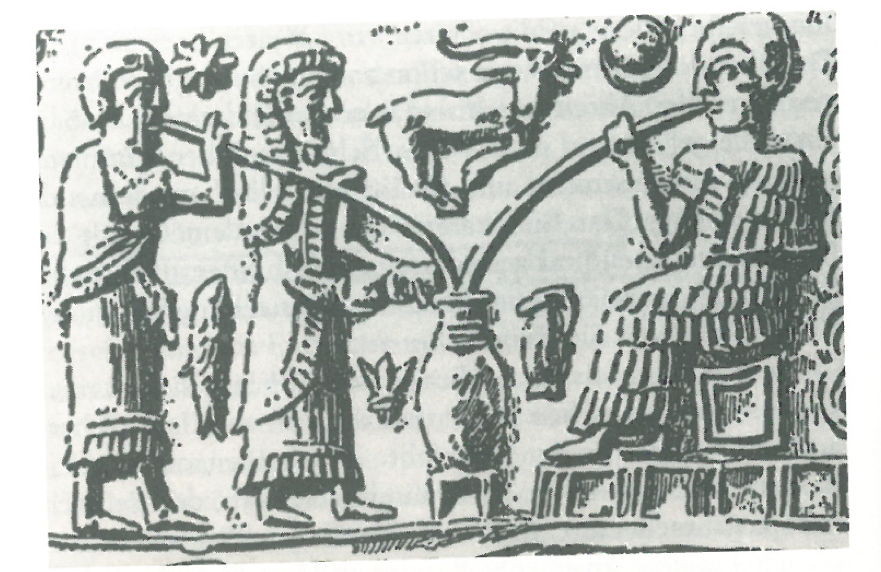
In summary, the diversity of theories that attempt to explain the origin of domestication suggest that it will be difficult to find a unifying model for all transitions into agriculture. Domestication occurred throughout human history in different regions of the world, and therefore it seems unlikely to find a simple or single explanation for this transition to agriculture and a sedentary lifestyle, which accompanied domestication. The different hypotheses usually emphasize particular aspects of the available archaeological and climatic information to explain the origin of agriculture.
Maybe the best explanation for the origin of agriculture was proposed by Jack Harlan, which is not based on a particular model (Harlan, 1992):
- Agriculture began more or less simultaneously in different regions of the world (8,000 - 6,000 BC), but the local circumstances were probably very different. Hence, a single model to explain the origin of agriculture will not be satisfactory.
- The most conspicuous differences between hunting-gathering and agricultural societies is the different size of human populations. Farming takes more work but can feed more people.
- In agriculture, children are an economic asset. They contribute to the labor force, provide wealth by dowries and bride-prices, and give security to the aged.
- However, there is a vicious circle: More people need more food, which requires more work and therefore more children.
- Agriculture provides more food than is necessary for subsistence. This leads to a division of labor and specialization, and allows the evolution of highly developed cultures and societies. The extent of the current division of labor is that two farmers feed more than 100 people.
Sources of evidence on the history of domestication and crop evolution
The study of domestication history relies on several disciplines to gather evidence and data (Harlan, Jack and de Wet, J. M. J., 1973): Archaeology, botany, genetics, chemistry, anthropology, agronomy, and linguistics.
The modern analysis of domestication relies on two major sources of information (Zohary et al., 2012):
- Archaelogical excavations that reveal plant remains
- Distribution and genetic variation of living plants as well as the analysis of traits involved in domestication (domestication syndrome) and of genetic differences between crops and their wild ancestors.
Archaeological evidence plays a crucial role in understanding the history and development of agriculture. This evidence is gathered through various specialized fields such as archaeobotany, which involves the identification of plant remains found during archaeological excavations. These remains are analyzed in connection with cultural associations and carbon-14 dating to determine the earliest signs of plant domestication and how these plants spread across different regions and cultures over time.
Additionally, artefacts such as dated tools related to the cultivation, harvesting, and processing of crops, as well as cultivation artefacts like irrigation canals, terraces, and plough marks, provide insights into agricultural practices.
Artistic representations such as early drawings, paintings, and reliefs also offer evidence of domesticated plants (Figure 2). Other methods include palynology, which examines pollen grains of crops and associated weeds found in dated cores or site contexts, and the examination of ancient DNA from plant remains. Chemical analyses help identify specific organic residues in charred seeds and ancient vessels, while starch analysis looks at tool use based on starch granules’ remnants.
Further evidence comes from studying living plants, where researchers search for the wild progenitors of domesticated crops using methods like comparative morphology and genetic analysis. Understanding the geographic distribution and ecology of these wild relatives sheds light on their natural adaptations and their evolution under domestication. This includes observing the morphological, physiological, and chemical changes that occur over time and how genetic variation is structured among crops and their wild progenitors.
Additional avenues of evidence include the genetic systems of plants, highlighting how reproductive and other systems adapt under domestication. Historical records, linguistic comparisons, and circumstantial geological, climatic, and ecological data also contribute to our understanding of how agriculture began and spread, thereby contributing to a comprehensive insight into agricultural origins and practices through multiple lenses of archaeological and botanical research.
Archaeological studies
Much of historical evidence on domestication originated from archaeological investigations that have several components. The excavation of archaeological sites such as old settlements reveals much about ancient lifestyles. Frequently, grains of wild and domesticated cereals are found, tools to process the plants, bones of humans and domesticated livestock (Figure 3) By comparing the shape of the grains with wild and cultivated existing forms, it is possible to infer whether grains from domesticated or undomesticated plants were found.
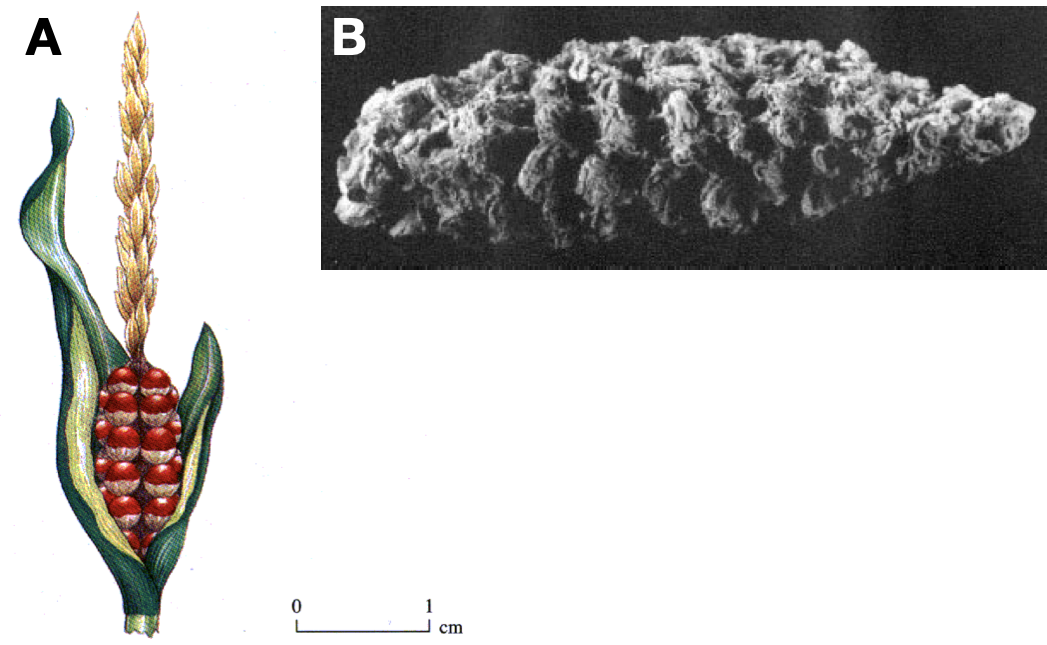
A second important source are pollen records. They can be identified easily and provide information both about the species and the frequency of species during different periods of past history in a geographic region.
Another archaeological record are inferences of weather patterns (that can also be obtained by interpreting pollen records) but also by measurements of isotopes in the archaeological remains, of ice cores (which can be used to infer global weather patterns) and other geochemical methods.
A relatively new method to investigating domestication is the analysis of ancient DNA, which has been extracted from plant material excavated at archaeological sites. Ancient DNA provides information about the genetic composition of the plants thousands of years ago and can be used to test hypotheses regarding the date, location and type of domestication. The main challenge with ancient DNA is that DNA is highly degraded and difficult to amplify to the amount needed for proper genetic analyses.
Radiocarbon dating
Radiocarbon dating provided to be a great progress in archaeology because it allows to determine absolute dates. It is based on the comparison of the concentration of radioactive, \(^{14}\text{C}\) isotopes to the concentration of \(^{12}\text{C}\) isotopes in archaeological material. \(^{14}\text{C}\) originates in the atmosphere by cosmic rays and is then incorporated into plants as \(^{14}\text{CO}_2\). At the timepoint of fixation the ratio of \(^{14}\text{C}/^{12}\text{C}\) is fixed but \(^{14}\text{C}\) decays at a constant rate, and hence the rate of the two isotopes is correlated to time with respect to the timepoint of incorporation of the \(^{14}\text{C}\) isotopes. The smaller the isotope ratio, the older the sample.
Although radiocarbon dating is a fairly old method and has been frequently criticised, it is still developed further and improved, thereby providing novel insights about archeological remains (Casanova et al., 2020).
Ancient DNA
Ancient DNA (or archeological DNA) is becoming increasingly important in the study of ancient remains and domestication history.
One of the first example sof a study using ancient DNA was performed on maize uncovered from archaeological sites in Mexico, where maize was domesticated from teosinte (Jaenicke-Despres et al., 2003). Three different genes were sequenced, of which one determines the plant architecture of modern maize, and should have been strongly selected during domestication. In two of the three genes, the ancient maize has the modern maize alleles, whereas in the third gene, the different ancient maize types have two alleles that are more frequent in modern maize than in modern teosinte (Figure 4). These data suggest that domestication associated selection and genetic drift created patterns of genetic variation already shortly after domestication and that allele frequencies have been quite ssince then.
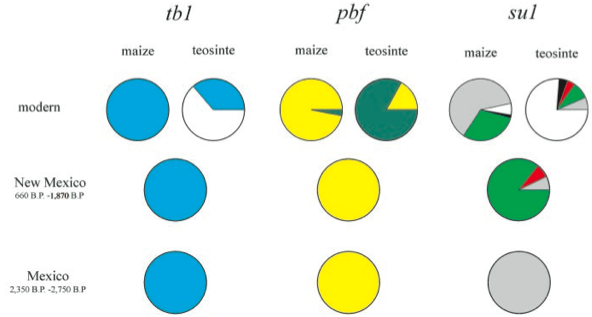
Now, the most modern DNA sequencing technologies are used to sequence the DNA from archaeological remains such as charred (carbonized) cereal grains to identify the different species and alleles present at a site (Bunning et al., 2012) and elucidate domestication history (Allaby et al., 2015). The sequencing of whole ancient genomes revealed novel insights about maize and barley domestication, for example.
Evidence from living plants
The comparison of the geographic distribution, phenotypic similarities and genetic similarities between domesticated crops and their wild ancestors is an important information on the history domesticated crops. The following questions can be asked in such comparisons:
- What are the key morphological, physiological, chemical and genetic changes between domesticated plants and their wild ancestors?
- What is the type (chromosomal, protein, DNA polymorphisms), level and geographic pattern of genetic variation? Which information does it provide on the domestication history of a crop?
- Which adaptations of wild ancestors have been lost in domesticates? Which adaptations are new in crops?
- What is the geographic distribution of wild ancestors?
Analysis of wild ancestors
To identify wild ancestors and compare them to crops, a variety of approaches are possible. First, the taxonomic approach compares morphological similarity to identify the wild ancestor. However, since crops are often extremely phenotypically variable this approach is often unreliable. Genetic analyses, either by doing crosses between wild ancestor and modern crop, or by DNA sequencing are more reliable for the identification of crop ancestors.
Wild ancestors can also be identified from the geographic distribution of putative wild ancestors, and the occurrence of seeds of crops in archaeological sites. The narrower the geographic distribution of an ancient crop the better the site of domestication can be identified. However, it is important to account for major climatic changes between the domestication and the age of the archaeological site because climate change may have caused range shifts (even locally) of wild ancestors.
Pioneers in the analysis of crop domestication and evolution
In spite of the internationalization of cultivated crops and in spite of all the human migrations and colonizations as well as the very antiquity of agriculture, it is still possible … to establish regions of endemic varieties and races, to discover regions where the maximum primary variation of strains occurred and to establish a number of regularities concerning the distribution of inherited characteristics.
– Nikolai Vavilov
Alphonse de Candolle
A description of the evidence used for studying the evolution of crops was provided by Alphonse de Candolle (1806-1893) as a French-Swiss botanist who wrote the book “Origin of Cultivated Plants” (1883)1. In this book, he included botanical, archaeological, historical and linguistic information to determine the origin of a crop.
1 Available at Gutenberg Project at this link
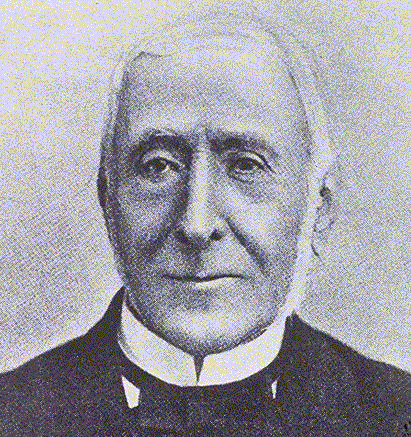
As historical information, he used historical records, ancient manuscripts or herbals. As linguistic evidence, he use names designating crops, expecially in native languages. For example with respect to the crops of the Andes, he concluded that quinoa (Chenopodium quinoa) originated there because the Quechua (language of the Incas) name was kinũa, and the Spanish name was then quinua.
Nikolai Vavilov
The Russian botanist and geneticist Nikolai Vavilov (1887-1943) (Wikipedia) was a pioneer in the analysis of domestication history. He travelled around the world to collect cultivated plants and their wild ancestors and obtained an intimate knowledge of the phenotypic diversity of crop plants (Figure 6).

Vavilov established a very active program of the study of crop diversity in the current Vavilov Institute of Plant Industry in St.Petersburg, Russia. Vavilov and his colleagues established germplasm collections of numerous plants to catalogue crop plant diversity. This collection is still one of the largest in the world2. The goal of his efforts was to determine the geographic distribution of morphological and physiological variation and then to identify regions with maximum diversity.
Vavilov called his method differentiation, taxonomical-geographical method for determining the centers of crop origin:
- Differentiate a plant into Linnean species.
- Determine the geographic distribution areas of these species.
- Determine in detail the composition of the varieties and races of each species and the inheritance of genetic variability.
- Establish the geographic distribution of inherited variation and determine the geographic center of accumulation of varieties.
This work led him to postulate the theory of the centers of crop domestication:
The region of maximum variation, usually including a number of endemic forms and characteristics as well, can usually, be considered as the center of type-formation.
From such centers, the domesticated species spread out into other regions of the world where they were cultivated. Vavilov defined six to eight centers of diversity that he considered to be the centers of domestication (Figure 7):
- China
- India
- Central Asia
- Near East
- Mediterranean
- Ethiopia
- Mesoamerica
- South America: Andes of Peru, Ecuador, Bolivia; Chile; lowlands: Brazil, Paraguay
They all have in common that they are located in mountainous regions between 20-45 degrees latitude and are characterized by a temperate climate.
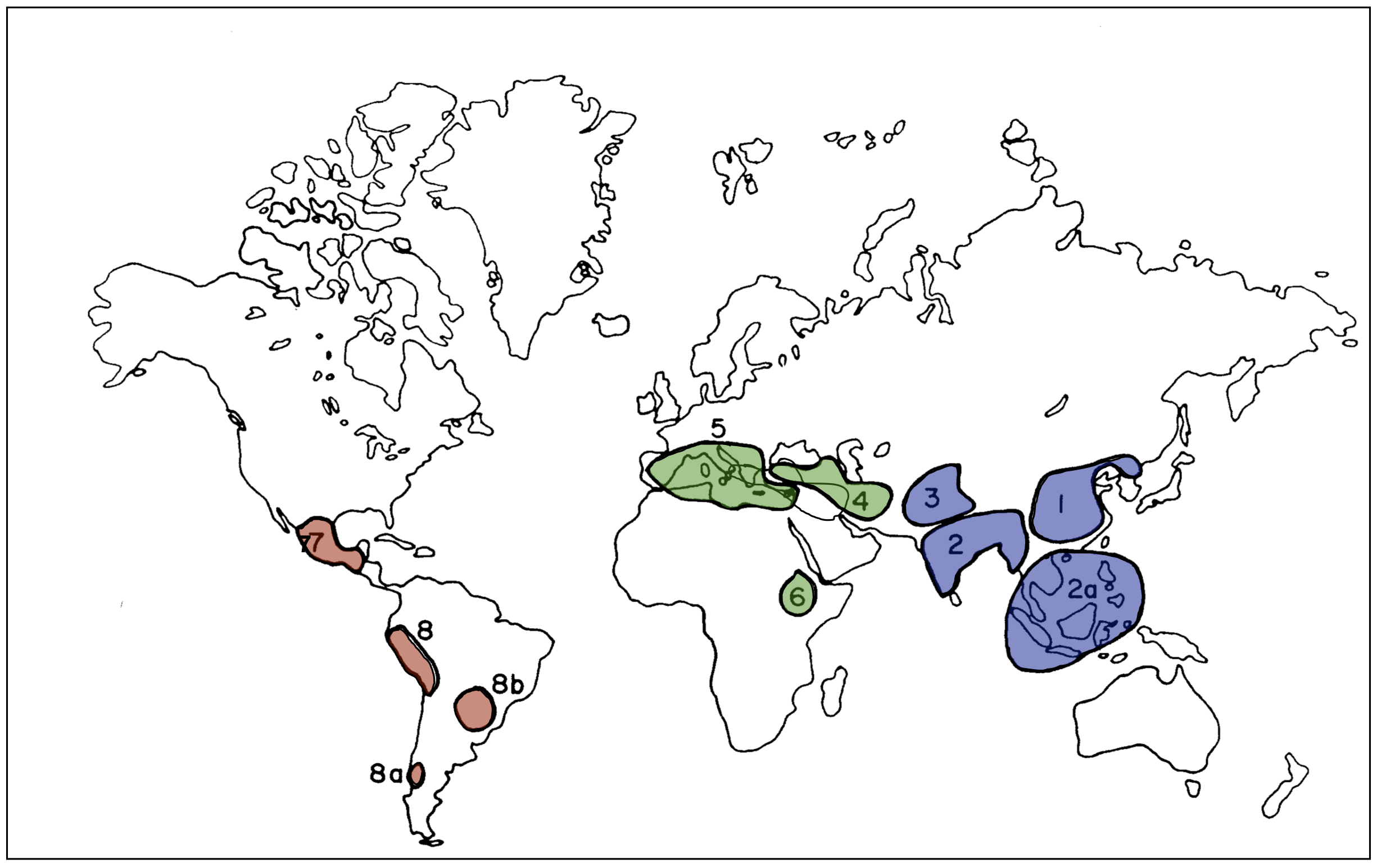
Vavilov made some additional important comments on the study of crop plant diversity that still apply today:
- He said that the wild ancestors of modern crops deserve the same research efforts than the cultivated species.
- Information from archaeology, history and linguistics should be utilized because they enhance information about the past history of cultivated plants.
- The center of origin of cultivated plants is often correlated with the center of origin of associated pathogens.
- It is necessary to distinguish primary and secondary centers of diversity.
The concept of the centers of diversity was expanded by a colleague of Vavilov, Zukhovski who subsequently defined megacenters. However, these are merely subdivisions of the world into regions, and suggest that no real localized centers of diversity exist.
Jack Harlan
Another leading of crop plant research was the American agricultural scientist Jack Harlan (1917-1998; Wikipedia). He strongly criticized Vavilov’s concept of centers of diversity because they were not consistent with his own observations in the field.

Harlan identified several problems in Vavilov’s theory:
- There are several cases whether the centers of origin are not the current centers of diversity anymore. For example, the genetic diversity of cultivated barley in the Near East, where it was presumably cultivated, is much lower than of Ethiopian barley varieties.
- The centers of diversity of different crops do not always coincide.
- There are secondary centers of diversity. They have a long history of continuous cultivation, are characterized by ecological and/or human diversity or are characterized by introgression with wild relatives or between different races of a crop.
In response, Harlan defined three centers and associated non-centers (Harlan, 1971). Centers are well-defined limited areas, whereas non-centers are vast areas (#tbl-centersnoncenters and Figure 9).
| Center | Non-center |
|---|---|
| Near East | Africa |
| China | South East Asia |
| Mesoamerica | South America |
According to Harlan, agriculture originated independently in the centers and the activities of domestication were dispersed over a span of 5,000 to 10,000 kilometers. He also suggested that centers and non-centers interact with each other and that there were domestication activities in the non-centers. One example is the finding of grinding equipment for cereal grains along the Nile that is 12,000 years old, and older than anything found in the Near East center. Harlan wondered whether the equipment was used to grind seeds of wild cereals and was then transferred by hunter-gatherers to the Near East where it was subsequently used to grind grains of wild wheat and barley which were then subsequently cultivated.
More recently, Harlan revised his center and non-center theory (Harlan, 1992). His new explanation is that some biomes or vegetation types are more conducive to domestication than others. A biome is a major regional terrestrial community with its own type of climate, vegetation, and animal life. Biomes are not sharply separated, but merge gradually into one another over what is called an ecotone. As Figure 10 shows, a biome does not have to be restricted to a particular geographic region but can be geographically disjunct.
The major biomes are tundra, evergreen coniferous forest (taiga, boreal forest), temperate deciduous forest, grasslands (prairie, steppe), deserts, dry shrubland, tropical savanna, tropical deciduous forest, tropical evergreen forest.
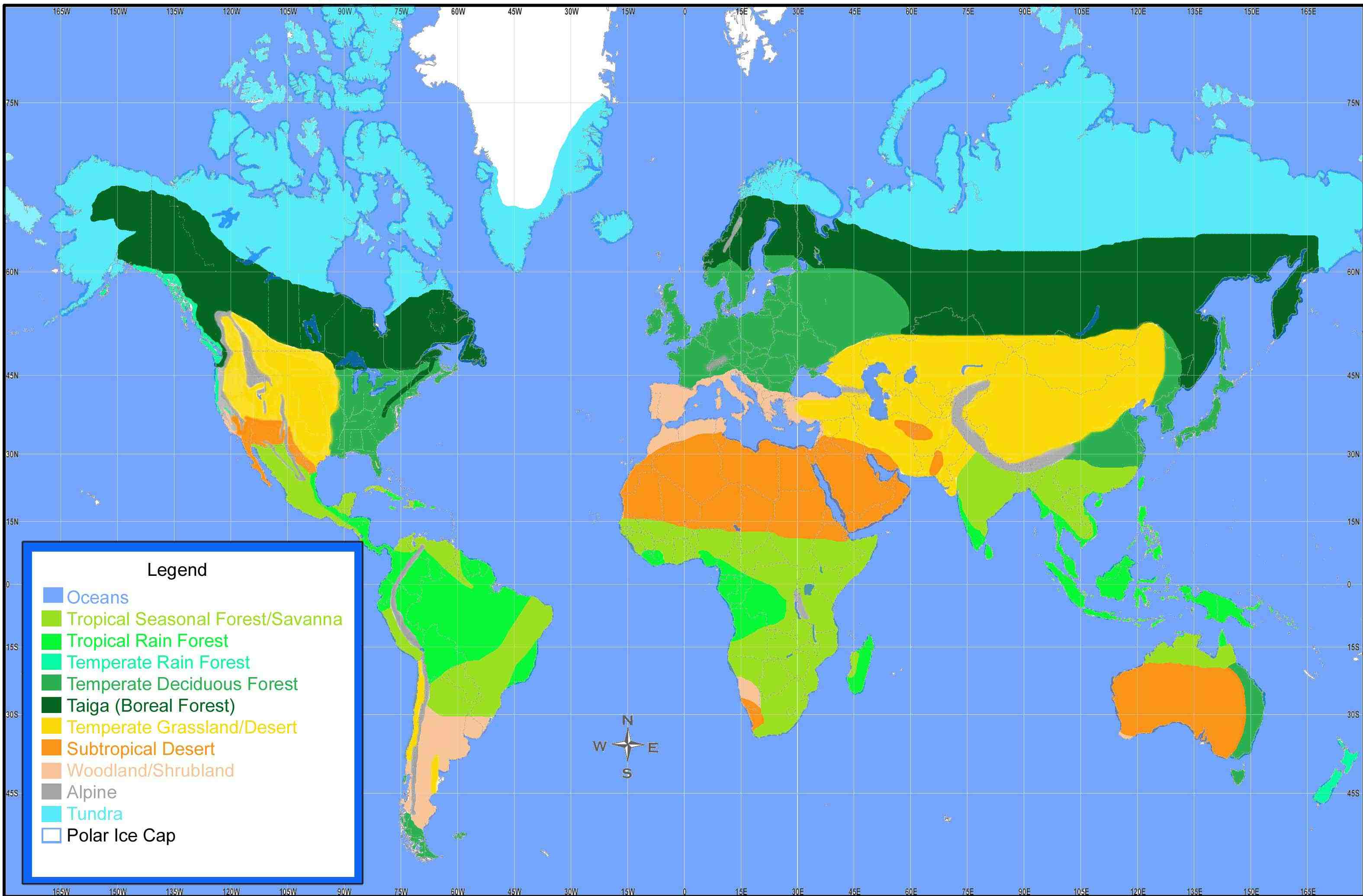
Harlan then classified the biomes according to their potential for agriculture:
- Tundra, taiga
- None
- Temperate prairies
- Sunflower
- Temerate steppes
- Proso millet, foxtail millet, hemp, Triticum tauschii: Donor of the D genome of bread wheat (\(AABBDD\))
- Tropical rain forest
- Sugarcane, banana and plantain, orange, mango, cacao
- Deserts
- Data palm
- Temperate forest
- Fruits and nuts like apple, pear, cherry, grape, walnut
- Tropical highlands
- Principally Andes with root crops such as potato, East Africa with Arabica coffee
- Sea coasts
- Coconut, cabbage, beet, cotton
- Mediterranean woodlands and tropical savannas
- These biomes are of particular importance. They provided more then 50% of the major crops. They have a long dry season either in the summer (Mediterranean woodlands) or in the winter (savanna) Mediterranean woodlands provided wheat, barley, pea, rapeseed. Savannas provided mostly seed annuals or tuberous perennials; the tuber remains dormant during the dry season. Crops include maize, rice, sorghum, cassava, sweet potato, bean, peanut, yams.
The geographic origin or crops is summarized in #tbl-croporigins.
| Region | Crops |
|---|---|
| North America | Sunflower, strawberry, grapevine, tobacco |
| Central America | Maize, Amaranth, Phaseolous, sweet potato, cassava, cotton, paprika, tomato, cocoa |
| South America | Amaranth, peanut, phaseolus bean, lupine, cassava, poatato, cotton, pineapple, pepper |
| Southeast Asia, India, Pacific region | Rice, yam, coconut, orange, banana, various spices |
| China | Rice, soja, yam, rapeseed, apricot, peach, cabbage, tea |
| Africa | Rice, pearl millet, sorghum, tef, oil palm, water melon, sesame, coffee |
| Near East | Wheat, barley, rye, oat, pea, lenses, lupines, rapeseed, olive, walnut, date palm, almond, apple, grapevine, plum, peach, onion |
By taking the ecological and other information into account, a synopsis of domestication of individual crops can be achieved as in #tbl-prosplants.
Crop Million tons Annual/ Ecology Self-/cross- Ploidy Perennial fertilizing ————– ————– ———– ————————- ————– ——–
Wheat 468 A Mediterranean woodlands S 2,4,6 Maize 429 A Tropical savanna C 2 Rice 330 A Tropical savanna S 2 Barley 160 A Mediterranean woodlands S 2 Soybean 88 A Woodlands S 2 Sugar cane 67 P Tropical forest W,C many Sorghum 60 A Tropical savanna S 2 Potato 54 A Tropical highland W,C 2,4,6 Oat 43 A Mediterranean woodlands S 2,4,6 Cassava 41 P Tropical savanna W,C 4 Sweet potato 35 A Tropical savanna W,C 6 Sugar beet 34 A Coastal C 2,3,4 Rye 29 A Mediterranean woodlands C 2 Millets 26 A Tropical savanna C,S 2,4 Rapeseed 19 A Mediterranean woodlands C 4,6 Beans 14 A Tropical savanna S 2 ————– ————– ———– ————————- ————– ——–
: Some key parameters of crops. Source: Harlan (1992). {#tbl-prosplants}
#tbl-prosplants can be summarized as follows:
- Half of major food crops originate either from savannas or Mediterranean woodlands.
- One third of the crops is outcrossing, one third self-fertilizing, the remainder is propagated by a combination of vegetative, outcrossing or self-fertilizing reproductive mode.
- Three quarters or crops are annual crops, only one quarter are perennial.
Which theory is most plausible?
Given that centers of crop biodiversity determine strategies for conservation and collection of genomic resources, it is of great interest to consider in which geographic regions a high diversity of genetic resources can be expected. This question was investigated using new empirical data, and it concluded that Vavilov’s original concept has the closest geographic coincidence with crop wild relative (CWR) hotspots (Maxted and Vincent, 2021).
A synopsis of domestication in the Old World
The relevant time periods for domestication in the Old World are:
- Epipaleolithic/Mesolithic
- Neolithic
- Bronze Age
The earliest signs of domestication were found in the prepottery Neolithic B (PPNB) farming villages, about 10,500 - 10,100 BP. They included spikelet forks of emmer and einkorn wheat with rough disarticulation scars, that indicate that seeds were not shattering anymore but had to be removed from the awns by threshing.
The domestication of these crops likely happened earlier. It is also unclear, there there was a single domestication event (e.g., in South East Turkey) or multiple domestication events in the Levant and the Northern Fertile Crescent.
Old world agriculture has several founder crops (#tbl-foundercrops).
| Type | Common Name | Scientific Name | Wild ancestor |
|---|---|---|---|
| Cereals | Emmer Wheat | Triticum turgidum subsp. dicoccum | T. turgidum ssp. dicoccoides |
| Einkorn wheat | T. monococcum ssp. monococcum | T. monococcum ssp. boeoticum | |
| Barley | Hordeum vulgare | H. spontaneum | |
| Pulses | Lentil | Lens culinaris | Lens orientalis |
| Peas | Pisum sativum | Pisum humile | |
| Other crops | Flax | Linum usitatissimum |
According to current knowledge, cereals were domesticated before the legumes, i.e., the transition to agriculture started with the cereals.
Other, minor founder crops include the two legume crops bitter vetch (Vicia ervilia) and chickpea (Cicer arietinum). It is important to note that the taxonomic classification of crops and their ancestors changes quite frequently. One of the reasons is the academic discussion whether it is better to classify both groups as different species, or as subspecies.
The distribution of the founder crops in different archaelogical sites of the Fertile Crescent is shown in Figure
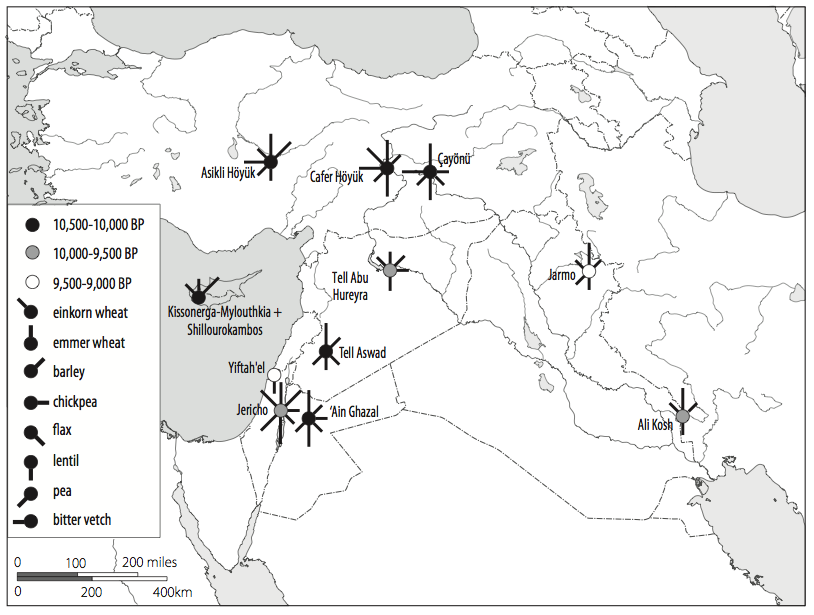
The archaeological evidence reveals that there are food packages consisting of at least one cereal, one legume and flax. In combination with the concurrent domestication of animals, in particular sheep and goats, one can also speak of a neolithic food production package consisting of vegetative crops and animals.
The archaelogical excavations also reveal a rapid transition from a hunter-gatherer lifestyle to a farming lifestyle. Epipaleolithic settlements contain much evidence for wild species that disappears rapidly in paleolithic settlements.
The key dates for the spread of agriculture into other regions are:
- 10,500 - 10,200 BC: First farming in the Levantine corridor
- 9,500 - 9,000 BC: Farming throughout the whole Fertile Crescent
- 9,000 - 8,500 BC: Agriculture has spread to Greece and Crete
- 8,000 BC: Agriculture in Bosnia-Hercegovina and Turkmenia (Turkmenistan); further spread to Spain and South Italy
- 7,500 BC: Evidence for agriculture is established throughout central Europe from Northern France over Germany to Poland
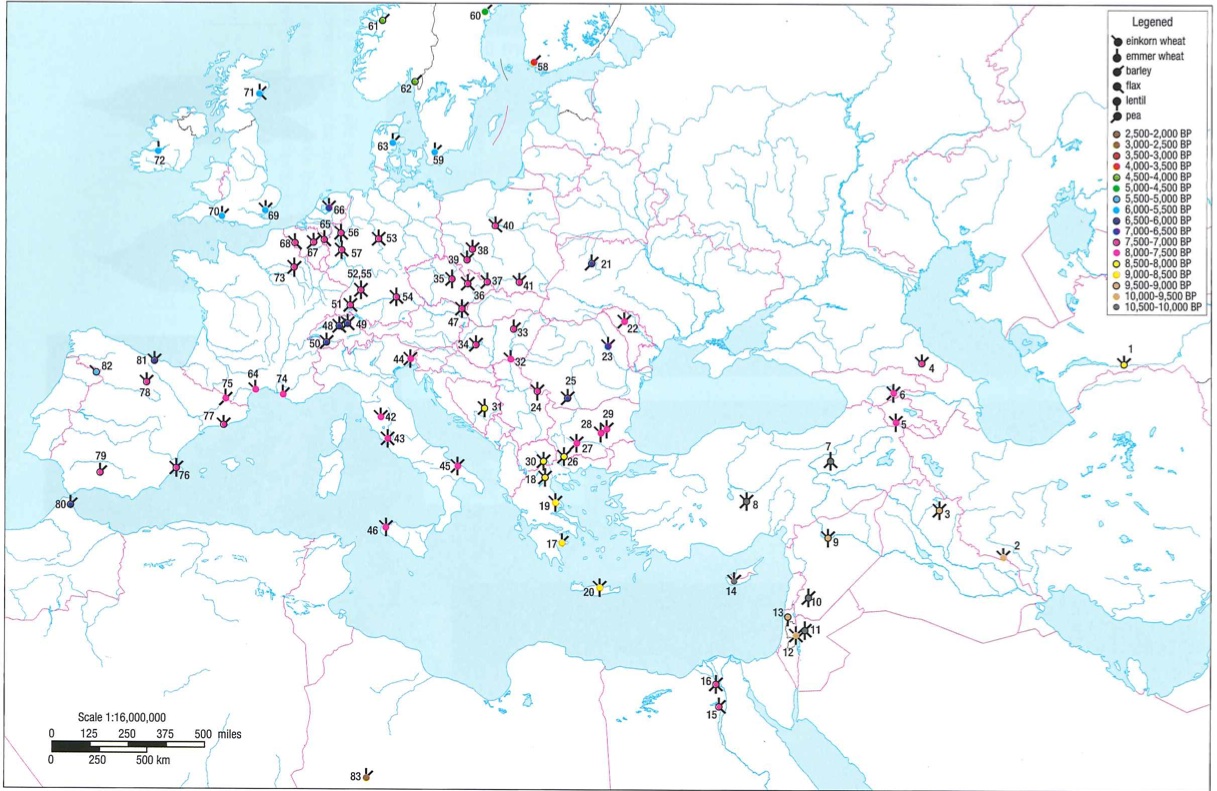
In all of these regions, agriculture was associated with einkorn and emmer wheat as well as with barley. Much less is known about the spread of agriculture into Central Asia because of a much lesser density of archaeological sites. Figure 13 summarizes the spread of agriculture outside the Fertile crescent.
Secondary domestication
Additional domestications took place outside the core area such as of poppy (Papaver somniferum) which was domesticated in western Europe, or chufa (Cyperus esculentus) in the Nile region, and Broomcor millet Panicum milliaceum in the Caspian basin and the Czech Republic. However, evidence for the exact geographic location is scant.
Horticulture (Fruit trees)
The first fruit crops were domesticated later, from 6,800-6,300 BC in the Calcolithic Levant. They included olive, grapevine, fig, date palm. Since 4,500 BC these crops were very abundant.
Other fruit crops such as apple, pear, plum and cherry appear much later, at about 1,000 BC Fruit domestication can be summarized as follows Zohary et al. (2012)
- The earliest definite signs of fruit domestication appear in the south-west Asia (Fertile Crescent)
- Horticulture developed only after the firm establishment of grain agriculture
- As with grain crops, several local wild fruits were taken into domestication at about the same time
- Domestication of fruit crops relied heavily on the invention of vegetative propagation
- Planting of perennial fruit trees is a long-term investment, promoting a fully settled way of life
- Soon after its successful establishment, horticulture spread from its original ‘core area’ into the territories in the Mediterranean Basin and south-west Asia
- After the introduction of grafting, the domestication of a whole group of ‘second-wave’ fruit crops became possible.
Domestication of vegetables
Vegetables consist of soft tissue which is hardly conserved, therefore the archaeological evidence is very limited.
In the Nile valley, garlic, leek, onion, lettuce, melon, watermelon were cultivated at 1,000 BC.
But in the Bronze age, vegetables were an important part of the food production system.
Secondary crops: From weed to crop
Some crops were weeds that accompanied the early domesticated crops. They were domesticated secondarily, whether on purpose or as a byproduct of natural selection. The latter hypothesis states that non-shattering genotypes were selected because the were harvested with the main crops and sowed again and therefore became domesticated accidentially. Because these weeds were selected to mimic domesticated crops, the process of secondary domestication was also called Vavilovian mimicry.
Examples of secondary crops are rye (Secale cereale), oat (Avena sativa) and gold of pleasure (Camelina sativa; also known as false flax, which explains its accidential domestication)
C. sativa is an important oil crop.
A global view on the history of agriculture and domestication events
There are differences in the origin of agriculture in the various regions of the world (Figure 14). Currently, four independent centers of domestication are recognized in the early holocene period from 12,000-8,200 BP (Larson et al., 2014). They are located in the Fertile Crescent, China, Central and Northwestern South America. Recently, a fifth center of domestication (or at least of agriculture) from the early holocene was postulated in the Bolivian lowlands (i.e., in Central South America) (Lombardo et al., 2020).
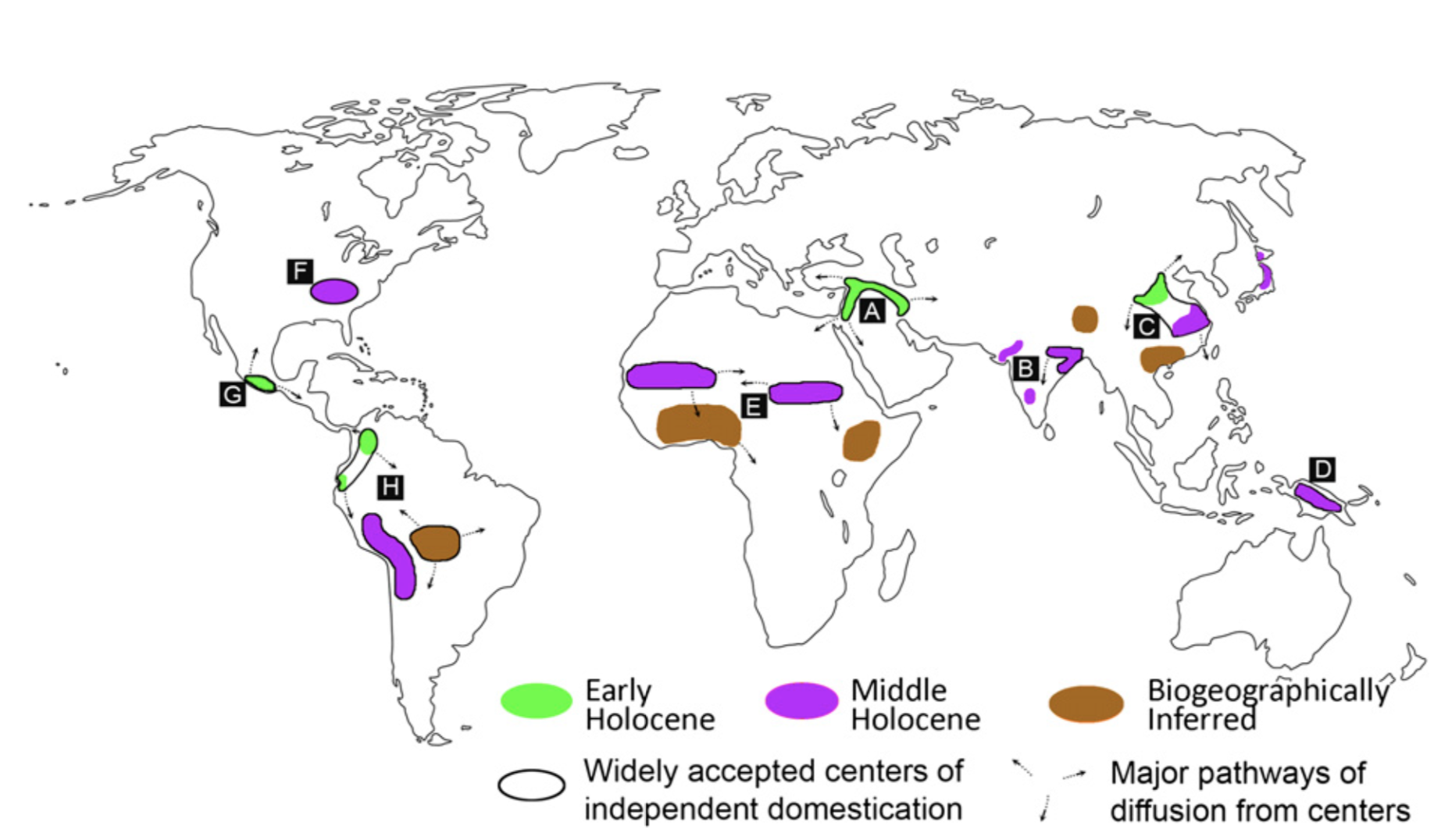
Estimated dates of domestication of crop plants are shown in #tbl-croporigins.
| Time | Crop plant | Reproduction | Center of origin |
|---|---|---|---|
| 1,000-today | Sugar beet | ob | Europe |
| 2,000 | Rape seed (canola) | ob/ib | Mediterranean |
| 3,000 | Sunflower | ob | North America |
| 4,000 | Potatos | ob (clonal) | South America |
| 5,000 | Oats | ib | Eastern Europe |
| Hemp | ob | China | |
| 6,000 | Rye | ob | Turkey |
| Millet | ib/ob/ | China | |
| Rice | ib | China | |
| 7,000 | Bean (Vicia faba) | ob | Near East |
| 8,000 | Cotton | ib/ob | Mexico |
| flax, linen seed | ib | Near East | |
| 9,000 | barley | ib | Near East |
| wheat | ib | Near East | |
| lentils | ib | Near East | |
| peas | ib | Near East |
Synopsis: Centers of diversity and domestication
The theory that there are centers of diversity has been modified considerably since its inception by Vavilov. One of the conclusions is that there are major centers of domestication on each continent that differ in their size and age (Figure 15)
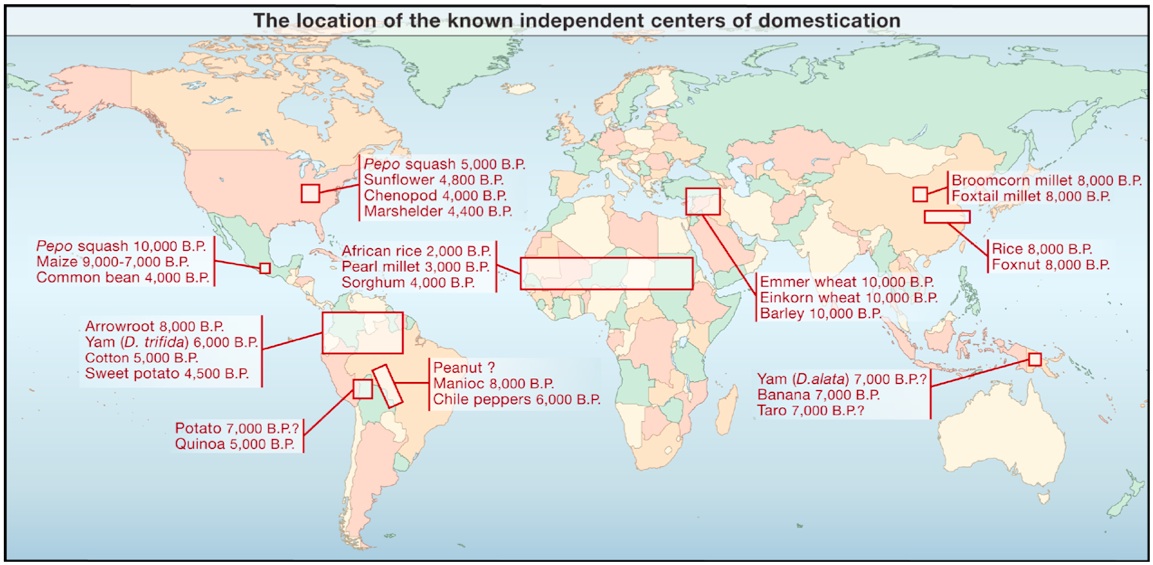
In hindsight, it seems that domestication began at similar points in time on different continents, but a comparison of dates suggests that in fact, it was not a synchronous process at all and likely was determined by the climate and cultural evolution specific to each region. However, it needs to be kept in mind that our degree of knowledge is not the same for all regions of the world. The center in the Near East is clrearly the best studied, the centers in sub-saharan Africa, for example are much less well studied. In the near future, the genetic analysis of crop species will lead to a greatly improved understanding of the domestication history of many crops, and in a synopsis, of the evolution of agriculture.
Key concepts
Summary
- There are numerous explanations for the origin of agriculture. Most likely none of them explains all transitions to agriculture and neither a single explanation is sufficient.
- Different types of evidence such as archeology, distribution of crops and genetics are used to define theories of domestication
- Vavilov and Harlan defined centers of diversity and domestication of crop plants. However, these definitions are not very strong, and likely will have to be revised as additional archeological and genetic data become available.
- These centers originated in different times in history and different crops were domesticated at different times.
- Each major domestication event included a cereal species for carbohydrates and a legume for protein.
Further reading
The best concise overview of the current state of domestication studies is Larson et al. (2014).
Detailed overviews can be found in:
- Jack Harlan, Of Crops and Man 2nd edition, Chapters 1,2 and 7
- Zohary et al., Domestication of Plants in the Old World. 4th Edition (2012) Chapters 1-3
Two very good biographies of Nikolai Vavilov:
- Peter Pringle, The Murder of Nikolai Vavilov, Simon and Schuster (2008)
- Gary Paul Nabhan, Where our food comes from - Retracing Nikolay Vavilov’s quest to end famine, Island Press (2009)
General summaries of the history of domestication:
- Bruce D. Smith, The Emergence of Agriculture, Scientific American Library (1995)
- Denis Murphy, People, plants and genes. Oxford University Press (2006), Chapters 1-3 and 9
Review and thinking questions
- Is it possible to test whether the environmental determinist hypothesis for the origin of agriculture is true? How would you do it
- Why is it unlikely that a single hypothesis explains all domestication events?
- What are the advantages of a ‘religous reasons’ or the ‘beer before bread’ hypothesis for the begin of the domestication rather than domestication for food? What are the disadvantages?
- Which processes may explain the multiple origins of agriculture in different regions of the world?
- Which methods are used for studying the origin of agriculture? What are their advantages and disadvantages?
- Why and how does ancient DNA provide information about the origin and geographic location of domestication?
- What are the strengths and weaknesses of the Vavilov’s method, of Harlan’s megacenter and the biome theories for the identifying centers of domestication and crop plant diversity?
- Which factors determine in your opinion which plant became domesticated and which ones did not?
- Do you think that all plant species that are suifor domestication have been domesticated? Why or why not?
Problems
- Fig. 2 of Larson et al. (2014) show domestication times of plants and animals in different centers of domestication. Can you recognize a pattern with respect to whether plants or animals were domesticated first? What is a problem with the data presented in the and which additional research could improve it?
- Figure 4 in the handout shows the fixation of alleles of three different genes of maize. If you compare the estimated age of maize domestication and the age of the maize cob analysed: Do the observed differences in the frequency of alleles provide some information about the speed of maize domestication? What are the limitations of this dataset and the analysis shown?
In class exercises
Recapitulation of key concepts
A short quiz on each of the following terms
\(\square\) Center of crop domestication | \(\square\) Holocene | \(\square\) Domestication package |
\(\square\) Loss of function mutation | \(\square\) Zoonosis | \(\square\) Pleiotropy |
Discussion questions
Discuss the questions in small groups of 2-3 students:
- Is it possible to test whether the environmental determinist hypothesis for the origin of agriculture is true? How would you do it?
- Why is it unlikely that a single hypothesis explains all domestication events?
- Which processes may explain the multiple origins of agriculture in different regions of the world?
- What are the strengths and weaknesses of the Vavilov’s method, of Harlan’s megacenter and the biome theories for the identifying centers of domestication and crop plant diversity?
- Which factors determine in your opinion which plant became domesticated and which ones did not?
- Do you think that all plant species that are suitable for domestication have been domesticated? Why or why not?
Conservation of crop wild relatives (CWR)
Maxted and Vincent (2021) conducted a large-scale analysis to compare the overlap of the geographic distribution of crop wild relatives with the four major models of crop domestication, which are shown in Figure 1.
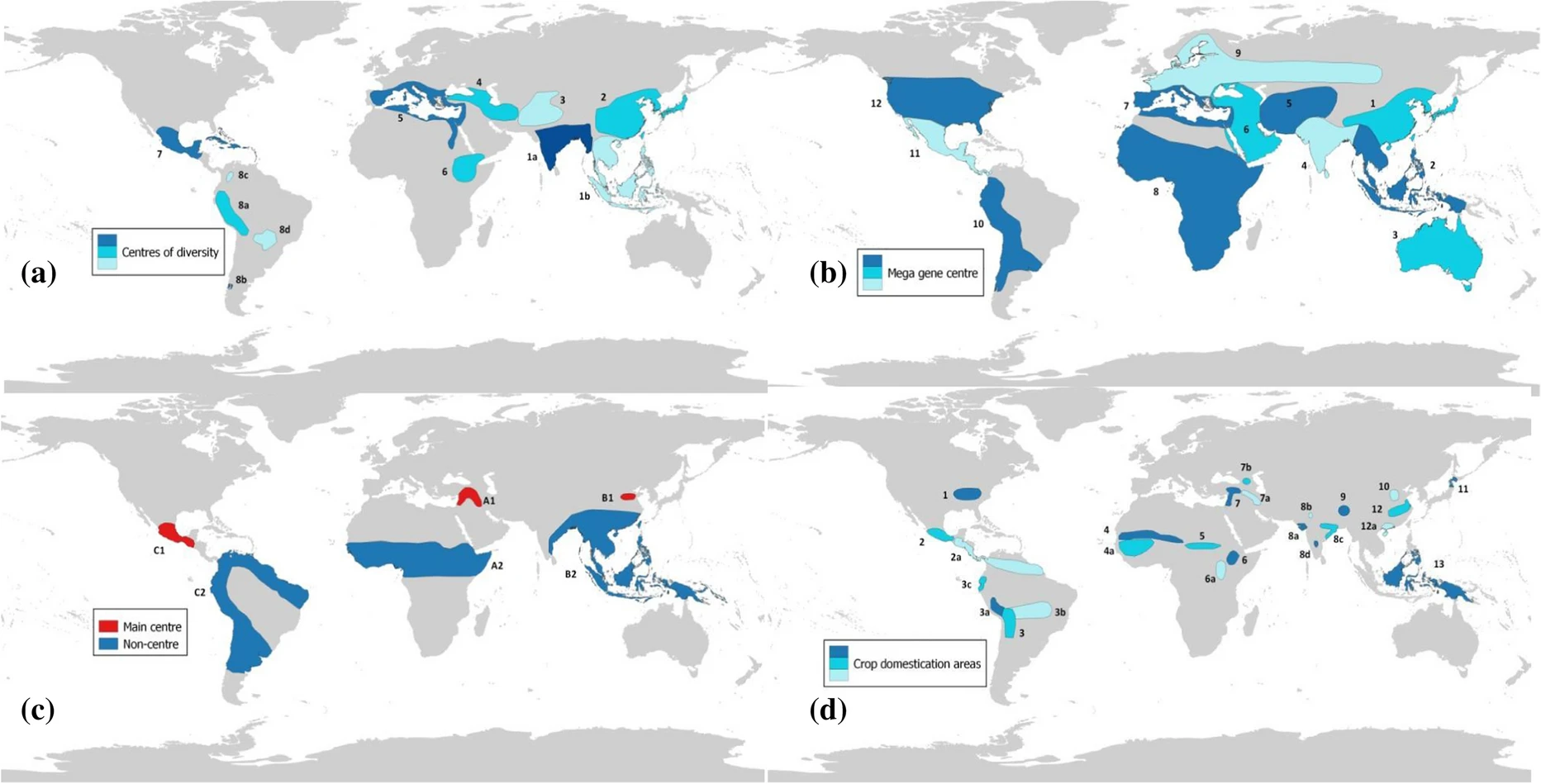
Maxted and Vincent collected geographic distribution data of crop wild relatives from different wild relatives from genepools 1 and gene pools 2 (closely related species of a given crop species that can be crossed with the crop species) and calculated a CWR species richness map as shown in Figure 2.
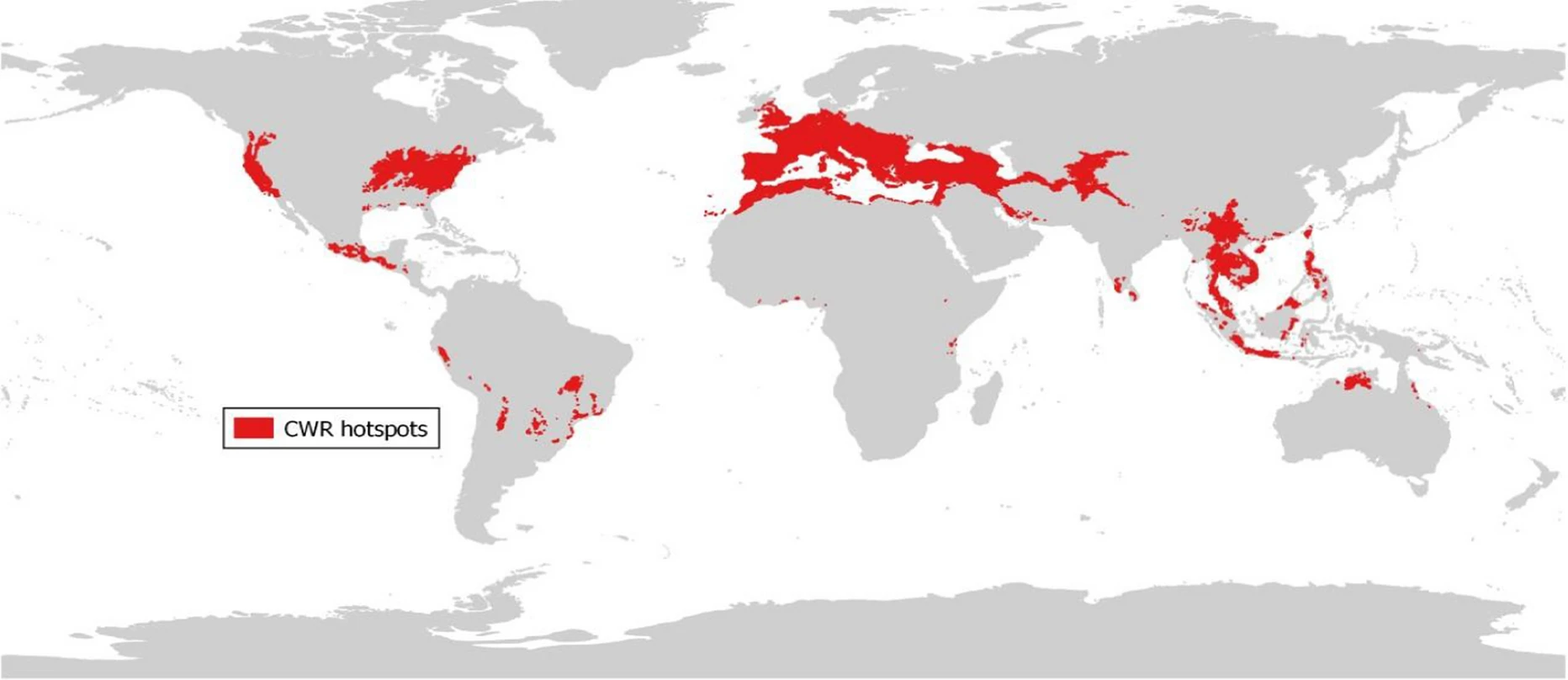
They then calculated the overlap of the species richness map with each of the maps resulting from the four different domestication models and calculated the relative overlap. Their result was that the greatest overlap was with Vavilov’s map, providing strong support for Vavilov’s approach. Figure 17 shows for comparison a map of global biodiversity.
Discussion questions:
- What are the key differences and similarities of four maps in Figure 1?
- The map of Figure 2 is essentially based on modeling the species distribution range of CWR. Which other, potentially important, information is missing and could be used for the test of the four hypotheses?
- How does the map in Figure 2 overlap with the map of global hotspots of biodiversity (see Figure 3)? Which conclusions can you draw from such a comparison?
- Why is it useful to know which model of domestication is the correct (or best) one for developing strategies to conserve and utilize crop wild relatives?

